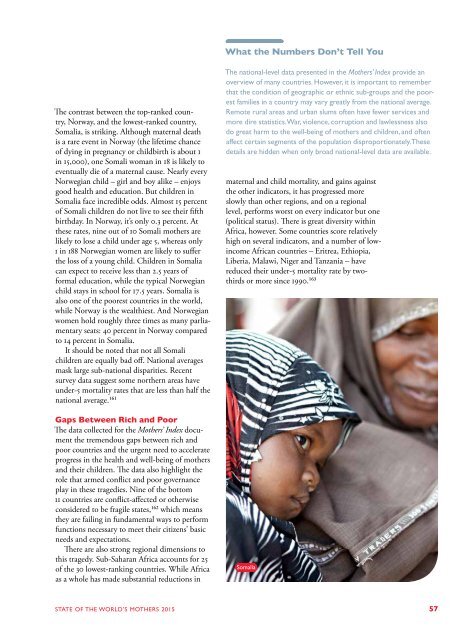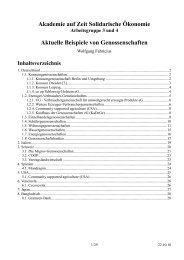sowm_2015__int__africa_full_report_low_res
sowm_2015__int__africa_full_report_low_res
sowm_2015__int__africa_full_report_low_res
Create successful ePaper yourself
Turn your PDF publications into a flip-book with our unique Google optimized e-Paper software.
What the Numbers Don’t Tell You<br />
The contrast between the top-ranked country,<br />
Norway, and the <strong>low</strong>est-ranked country,<br />
Somalia, is striking. Although maternal death<br />
is a rare event in Norway (the lifetime chance<br />
of dying in pregnancy or childbirth is about 1<br />
in 15,000), one Somali woman in 18 is likely to<br />
eventually die of a maternal cause. Nearly every<br />
Norwegian child – girl and boy alike – enjoys<br />
good health and education. But children in<br />
Somalia face incredible odds. Almost 15 percent<br />
of Somali children do not live to see their fifth<br />
birthday. In Norway, it’s only 0.3 percent. At<br />
these rates, nine out of 10 Somali mothers are<br />
likely to lose a child under age 5, whereas only<br />
1 in 188 Norwegian women are likely to suffer<br />
the loss of a young child. Children in Somalia<br />
can expect to receive less than 2.5 years of<br />
formal education, while the typical Norwegian<br />
child stays in school for 17.5 years. Somalia is<br />
also one of the poo<strong>res</strong>t countries in the world,<br />
while Norway is the wealthiest. And Norwegian<br />
women hold roughly three times as many parliamentary<br />
seats: 40 percent in Norway compared<br />
to 14 percent in Somalia.<br />
It should be noted that not all Somali<br />
children are equally bad off. National averages<br />
mask large sub-national disparities. Recent<br />
survey data suggest some northern areas have<br />
under-5 mortality rates that are less than half the<br />
national average. 161<br />
Gaps Between Rich and Poor<br />
The data collected for the Mothers’ Index document<br />
the tremendous gaps between rich and<br />
poor countries and the urgent need to accelerate<br />
prog<strong>res</strong>s in the health and well-being of mothers<br />
and their children. The data also highlight the<br />
role that armed conflict and poor governance<br />
play in these tragedies. Nine of the bottom<br />
11 countries are conflict-affected or otherwise<br />
considered to be fragile states, 162 which means<br />
they are failing in fundamental ways to perform<br />
functions necessary to meet their citizens’ basic<br />
needs and expectations.<br />
There are also strong regional dimensions to<br />
this tragedy. Sub-Saharan Africa accounts for 25<br />
of the 30 <strong>low</strong>est-ranking countries. While Africa<br />
as a whole has made substantial reductions in<br />
The national-level data p<strong>res</strong>ented in the Mothers’ Index provide an<br />
overview of many countries. However, it is important to remember<br />
that the condition of geographic or ethnic sub-groups and the poo<strong>res</strong>t<br />
families in a country may vary greatly from the national average.<br />
Remote rural areas and urban slums often have fewer services and<br />
more dire statistics. War, violence, corruption and lawlessness also<br />
do great harm to the well-being of mothers and children, and often<br />
affect certain segments of the population disproportionately. These<br />
details are hidden when only broad national-level data are available.<br />
maternal and child mortality, and gains against<br />
the other indicators, it has prog<strong>res</strong>sed more<br />
s<strong>low</strong>ly than other regions, and on a regional<br />
level, performs worst on every indicator but one<br />
(political status). There is great diversity within<br />
Africa, however. Some countries score relatively<br />
high on several indicators, and a number of <strong>low</strong>income<br />
African countries – Eritrea, Ethiopia,<br />
Liberia, Malawi, Niger and Tanzania – have<br />
reduced their under-5 mortality rate by twothirds<br />
or more since 1990. 163<br />
Somalia<br />
STATE OF THE WORLD’S MOTHERS <strong>2015</strong> 57




